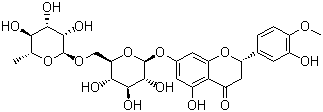
Hesperidin
Name: Hesperidin
Synonyms: (S)-7-[[6-O-(6-Deoxy-alpha-L-mannopyranosyl)-beta-D-glucopyranosyl]oxy]-2,3-dihydro-5-hydroxy-2-(3-hydroxy-4-methoxyphenyl)-4H-1-benzopyran-4-one; Vitamin P
Molecular Structure:
 Molecular Formula: C28H34O15
Molecular Weight: 610.57
CAS Number: 520-26-3
EINECS: 208-288-1
Hesperidin is a flavanone glycoside (flavonoid) found abundantly in citrus fruits. Its aglycone form is called hesperetin. Hesperidin is believed to play a role in plant defense. Hesperidin acts as an antioxidant according to in vitro studies. In human nutrition Hesperidin contributes to the integrity of the blood vessels. Hesperidin reduced cholesterol and blood pressure in rats. In a mouse study large doses of the glucoside hesperidin decreased bone density loss. Another animal study showed protective effects against sepsis. Hesperidin has anti-inflammatory effects. Hesperidin is also a sedative, possibly acting through opioid or adenosine receptors. Hesperidin also showed the ability to penetrate the blood brain barrier in an in vitro model.
Hesperidin is useful in treating the complaints of menopause and in dealing with the viruses that cause herpes, the flu, and certain respiratory ailments. Supplemental hesperidin may also help reduce edema or excess swelling in the legs due to fluid accumulation. Hesperidin is extensive used for medicine, food additive, medical cosmetic, nutritional cosmetic and healthcare industries.
Specification
Package: with visual double aseptic food poly bags inside. 25kgs per carton with 10 bags inside, 2.5kg per bag or according to customer requirement.
Storage: Stored in a dry and cool place, keep away from strong light and heat.
Shelf life: Two years when stored properly in a well-closed container. |